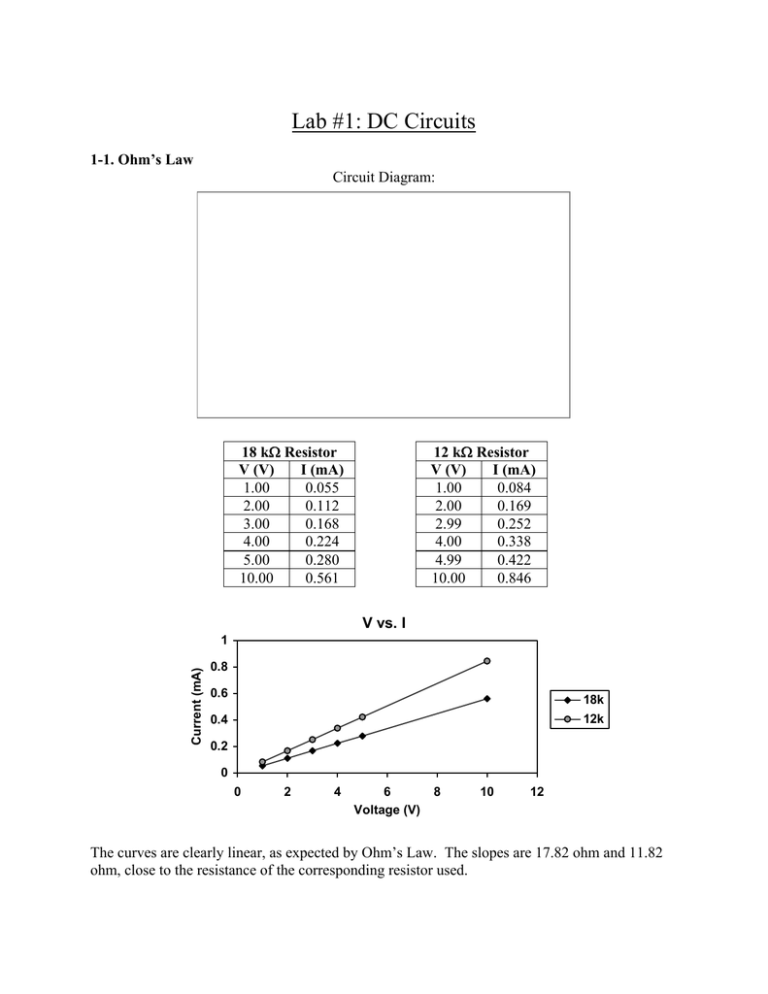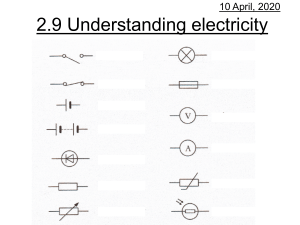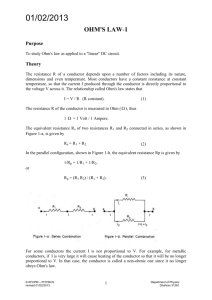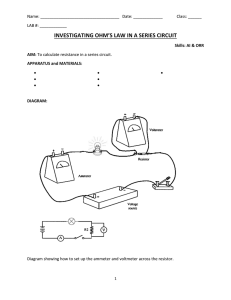Lab #1: DC Circuits
advertisement

Lab #1: DC Circuits 1-1. Ohm’s Law Circuit Diagram: 12 kΩ Resistor V (V) I (mA) 1.00 0.084 2.00 0.169 2.99 0.252 4.00 0.338 4.99 0.422 10.00 0.846 18 kΩ Resistor V (V) I (mA) 1.00 0.055 2.00 0.112 3.00 0.168 4.00 0.224 5.00 0.280 10.00 0.561 V vs. I Current (mA) 1 0.8 0.6 18k 12k 0.4 0.2 0 0 2 4 6 Voltage (V) 8 10 12 The curves are clearly linear, as expected by Ohm’s Law. The slopes are 17.82 ohm and 11.82 ohm, close to the resistance of the corresponding resistor used. In the circuit diagram above we can see that the voltmeter is measuring any voltage drop across the resistor or ammeter. If the ammeter were ideal, then its internal resistance would be zero and consequently there would be no voltage drop across it. In reality, the ammeter will have nonzero resistance. We can try to fix the problem by moving the terminals of the voltmeter to cross only the resistor. However, this introduces a new problem. The voltmeter is now directly in parallel to the resistor, so that the measured current will now be the current passing through the resistor plus the current passing through the voltmeter. If the voltmeter were ideal, it would have infinite resistance and there would be no current passing through it. In that case, our measurements would not be affected. It is possible to measure the internal resistance of the ammeter and voltmeter (configured for this experiment) by placing each device in series with a resistor comparable to the internal resistance of the device. In the case of the voltmeter, we placed it in series with a 20M resistor and set the input voltage at 5.00 V. The voltage measured by the voltmeter was only 1.66 V. We can compute the internal resistance knowing the voltage divider equation: Vmeas = [ Rint / (Rint + Rext ) ] Vin Solving, Rint = [ Vmeas / (Vin - Vmeas) ] Rext = [1.66/3.34]20 Mohm = 9.94 Mohm ~ 10 Mohm. In the case of the ammeter, we placed it in series with a 1kohm resistor and set the input voltage at 0.20 V. We know Imeas (Rext + Rint) = Vin, or, after solving, Rin = Vin/Imeas-Rext = (0.20 V)/(.173 mA) -(1.0 k ohm)~ 150 ohm Knowledge of the internal resistance of our measuring devices allows us to estimate the error for the two possible positions our voltmeter may be in. If the voltmeter is across only the resistor, then it draws about Rext /(Rext + Rint) = (20 k)/(10 M) = 0.002 (or 0.2%) of the current away from the 20k resistor. On the other hand, if the voltmeter is across both resistor and ammeter, then the ammeter draws about Rint /(Rext + Rint) =150/20k = 0.0075 (or 0.8%) of the voltage away from the resistor. Thus, in our case, it is preferable by a small margin to place the voltmeter across the resistor. This conclusion would be reversed if we were trying to measure a 20M resistor since then placing the voltmeter directly across the resistor will have it draw out 1/3 of the current. 1-2. An incandescent lamp Circuit Diagram: #47 Lamp V (V) I (mA) 1.00 52.6 2.00 77.8 3.00 98.3 4.00 115.5 5.00 132.0 Current (mA) V vs. I 140 120 100 80 60 40 20 0 0 1 2 3 Voltage (V) 4 5 6 The curve is not linear. Instead, it curves down slightly towards the voltage axis. Thus, the light bulb does not obey Ohm’s Law. Since resistance can be thought of as the derivative of voltage with respect to current, the light bulb has no clear, constant resistance. Instead, one can only specify the resistance as a function of the current. One possible explanation for the funny shape of the curve is that as voltage increases, the lamp filament heats up. This heating can directly change the resistance of the filament. Another possible explanation is that as the light bulb grows brighter and heats up, more power is extracted from the circuit. This power is tapped from the current, causing the curve to slope down as it does. 1-3. The Diode Circuit Diagram: 1N914 Diode V (V) I (mA) 0.37 0.009 0.45 0.045 0.48 0.088 0.53 0.210 0.54 0.297 0.56 0.403 V vs. I Current (mA) 0.5 0.4 0.3 0.2 0.1 0 0 0.2 0.4 0.6 Voltage (V) 0.8 1 0.8 1 V vs. I Semi-Log Plot Current (mA) 1 0.1 0.01 0.001 0 0.2 0.4 0.6 Voltage (V) The linear plot curve looks exponential. The semi-log plot curve looks linear. Thus, we can safely assume the V-I dependence is exponential. If you were to put 5 volts across the diode, as the curve tells you, the current would increase to a gigantic amount. This would definitely blow out the diode. When we reversed the direction of the diode, almost zero current (measured to be < ___A) flowed across it, no matter what resistor value we used. 1-4. Voltage Divider Circuit Diagram: Open Open circuit output voltage: Loaded circuit output voltage: Short circuit current: Loaded 7.56 V 5.05 V 1.497 mA VTh = Vopen = 7.56 V RTh = VTh / Ishort = 7.56V / 1.497mA = 5.05k Thevenin Circuit Diagram: Open circuit output voltage: Loaded circuit output voltage: Short circuit current: 7.59 V √ 5.02 V √ 1.474 mA √ The Thevenin equivalent circuit behaves identically to the original circuit, as expected.







